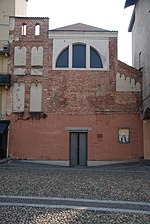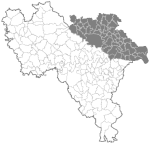Santa Maria del Carmine, Pavia
14th-century Roman Catholic church buildings in Italy15th-century Roman Catholic church buildings in ItalyGothic architecture in LombardyRoman Catholic churches completed in 1450Roman Catholic churches completed in 1461 ... and 2 more
Roman Catholic churches in PaviaTowers completed in the 15th century

Santa Maria del Carmine is a church in Pavia, Lombardy, northern Italy, considered amongst the best examples of Lombard Gothic architecture. It was begun in 1374 by Gian Galeazzo Visconti, Duke of Milan, on a project attributed to Bernardo da Venezia. The construction followed a slow pace, and was restarted in 1432, being finished in 1461.
Excerpt from the Wikipedia article Santa Maria del Carmine, Pavia (License: CC BY-SA 3.0, Authors, Images).Santa Maria del Carmine, Pavia
Via Roma, Pavia Borgo Ticino
Geographical coordinates (GPS) Address External links Nearby Places Show on map
Geographical coordinates (GPS)
| Latitude | Longitude |
|---|---|
| N 45.187222222222 ° | E 9.1530555555556 ° |
Address
Chiesa di Santa Maria del Carmine
Via Roma
27100 Pavia, Borgo Ticino
Lombardy, Italy
Open on Google Maps











